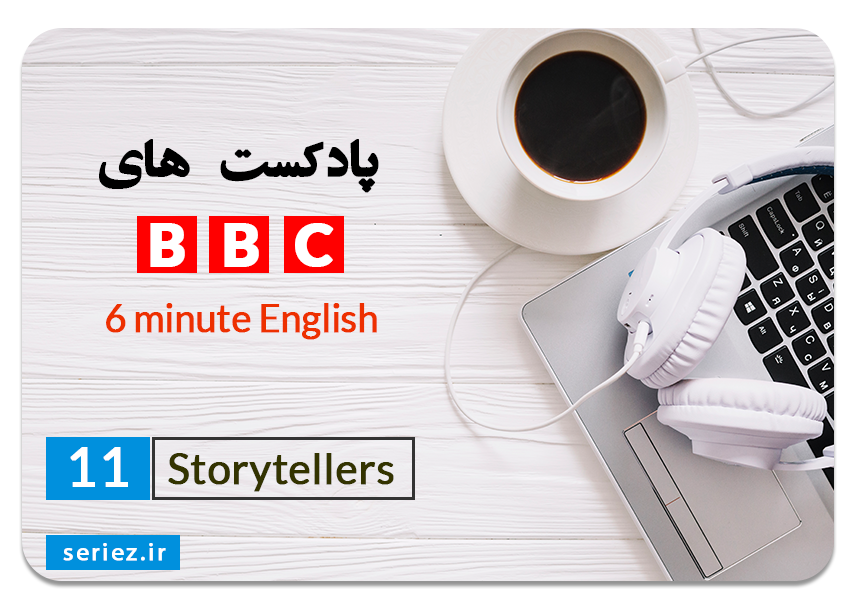پادکست های BBC 6 minute English – storytellers

قسمت یازدهم پادکست های BBC 6 Minute English
در بخش یازدهم پادکست های ۶ دقیقه ای بی بی سی، 6 لغت مهم با محوریت موضوع storytellers (داستان سرایان) بررسی می شود.
- ابتدا پادکست را بدون متن گوش کنید.
- آن را دوباره به همراه متن گوش دهید و
- در مرحله آخر لغات آن را مرور کنید.
پادکست شماره 11 (storytellers)
folk tales قصه های کهن
Ex: This is a folk tale which is a story handed down orally among the common people.
این یک داستان عامیانه است که درمیان عامه مردم به صورت دهان به دهان گشته است.
universal جهانی، همگانی
Ex: greed is the universal human weakness.
ضعف عمومی بشر حرص و آز است.
tap into فهمیدن ، ارتباط برقرار کردن و بیان کردن چیزی، مثل باور ها و نگرشات مردم نسبت ب موضوعی
Ex: If only we could tap into all that energy and creativity.
چه خوب میشد اگه میتونسیم با تموم اون انرژی و خلاقیت ارتباط برقرار کنیم.
wish-fulfillment برآوردن آرزو یا خواست، به مراد دل رسیدن
Ex: When you can take the route made of imagination, best-case scenarios and wish fulfillment, you’d be nuts not to take a deceitful stroll toward your goals, right?
زمانیکه می توانید مسیری را که از تصور و خیال ساخته شده دنبال کنید، در بهترین حالت و بهترین آرزو و خواست ها، اگر در مسیر هدف هاتون به صورت فریبانه قدم برندارید دیوانه اید مگه نه؟
ramble هذیان گفتن، پرت و پلا گفتن
Ex: Sorry, I’m rambling (on) – let me get back to the point.
ببخشید دارم چرت و پرت میگم بزار برگردیم سر اصل موضوع
get to the point برو سر اصل مطلب
Ex: Sorry, I’m rambling (on) – let me get back to the point.
ببخشید دارم چرت و پرت میگم بزار برگردیم سر اصل موضوع.
Neil
Hello. This is 6 Minute English from BBC Learning English. I’m Neil.
Georgina
And I’m Georgina.
Neil
Let me tell you a story, Georgina. Are you ready?
Georgina
Yes!
Neil
Grandma had always warned me not to look into the mirror at midnight. There was something strange about that mirror, she said. How childish – to believe silly stories! Later that night I heard a noise. I woke up, dark and alone. A clock chimed midnight. The floorboards were creaking as I walked towards the mirror. I looked into my face reflecting in the glass, when suddenly – my eye winked!
Georgina
Agh, stop Neil! You’re scaring me!
Neil
Oh sorry, Georgina! OK, let’s try another story: Once upon a time there was a beautiful servant girl who lived with her wicked stepmother and two jealous stepsisters…
Georgina
Ah, that’s better, Neil, and I know this story – Cinderella – more romantic and much less scary!
Neil
As you can see from Georgina’s reaction, telling stories is a powerful way to connect and communicate with people – and the topic of this programme.
Georgina
Stories help us make sense of the world, which is why we’ve been telling them to each other for millennia – and why some of the earliest folk tales – stories that parents have told and passed on to their children over many years – are still being told today.
Neil
According to the novelist Sandra Newman, and other academics, there are seven classic plotlines which are constantly being recycled into new stories. They include ‘rags to riches’ plots, like Cinderella…
Georgina
‘Defeating the monster’ plots, like Dracula…
Neil
…and other plots such as ‘comedies’, ‘adventures’ and ‘tragedies’. So, my quiz question is this: which of the following well-known folk tales is a ‘defeating the monster’ story? Is it:
a) Beowulf?
b) Beauty and the Beast? or,
c) Goldilocks and the Three Bears?
Georgina
Well, they all have beasts, bears or wolves in the title, so I’ll guess b) Beauty and the Beast.
Neil
OK, Georgina, we’ll come back to that later. It’s interesting to ask how we can explain the lasting appeal of these classic plotlines. Someone who might know is anthropologist and writer, Professor Jamie Tarani.
Georgina
Here he is talking to BBC World Service’s, The Why Factor. See if you can spot his answer.
Jamie Tarani
Often the reason why we feel so motivated to pass on stories is because the stories do tap into certain universal human fantasies and fears that will often transcend the concerns of particular times and places. We are intensely moralistic – most of the time, the bad guys have unhappy endings and the good guys have happy endings. We know that in the real world it doesn’t actually work like that so there’s an element of wish-fulfillment that somehow satisfies our moral appetite.
Neil
Stories from very different cultures often have plots with similar fantasies and fears. These human emotions are universal, meaning they exist everywhere and relate to everyone in the world.
Georgina
Classic stories work because they tap into basic human emotions – they understand and express what it means to be human.
Neil
Unlike in the real world, stories can reinforce our sense of morality – evil stepmothers get punished, Cinderella marries her prince and everyone lives happily ever after. In this way they create wish-fulfillment – the achievement of what we really want and desire.
Georgina
Well, so much for plotlines, Neil, but that still doesn’t explain how stories have the power to catch and hold our attention.
Neil
Let’s hear from novelist Sandra Newman, author of How Not To Write a Novel – a handbook of over 200 common mistakes.
Georgina
Here she tells BBC World Service’s, The Why Factor, that her absolute number one storytelling rule is comprehensibility – people need to understand your story.
Sandra Newman
There are some people who actually are so unfortunately bad at communicating that even when they tell a story to another person it becomes incomprehensible. And gradually as they stop making sense and ramble and digress and don’t know where they’re going, you see everybody not only lose interest but become hostile – people become very frustrated when someone is not getting to the point.
Neil
According to Sandra, the biggest mistake is incomprehensibility or not understanding the plot because the storyteller is rambling – talking in a confused way, going off the subject or not making sense.
Georgina
When listeners give a story their time and attention, they want the storyteller to get to the point – start talking about the most important and relevant information.
Neil
But to cut a long story short, Georgina, it’s time to return to the quiz question. Remember I asked you which famous folk tale had a ‘defeating the monster’ plot. What did you say?
Georgina
I said the answer was b) Beauty and the Beast. Was I right?
Neil
Your answer was…
Georgina
Oh, do get to the point, Neil!
Neil
…wrong! In fact, the answer is, a) Beowulf – an Old English epic about the hero, Beowulf, who defeats dragons and beasts.
Georgina
Well, Neil, there are two sides to every story, as the saying goes. So, let’s recap the vocabulary we’ve learned, starting with folk tales – popular stories that have been told and passed down over generations.
Neil
Many folk tales contain universal ideas – ideas which exist everywhere, in every age and culture. Stories tap into these ideas, meaning they understand, connect to and express them.
Georgina
Wish-fulfillment means the achievement or realisation of things you really want and desire.
Neil
A good storyteller will never ramble – talk in a confused way, often going off the subject or not making much sense.
Georgina
And instead will get to the point – start talking about what is most important and relevant.
Neil
That’s all we have time for, but remember to join us again soon for the inside story on trending English topics and vocabulary, here at 6 Minute English. Bye for now!
Georgina
Goodbye!
حال می توانید به سوال های زیر پاسخ دهید:
- what are folk tales? and is it important to use them?
- what is the best way to tell a story in order not to make it boring?
جواب هاتون رو کامنت کنید…


دیدگاهتان را بنویسید
برای نوشتن دیدگاه باید وارد بشوید.